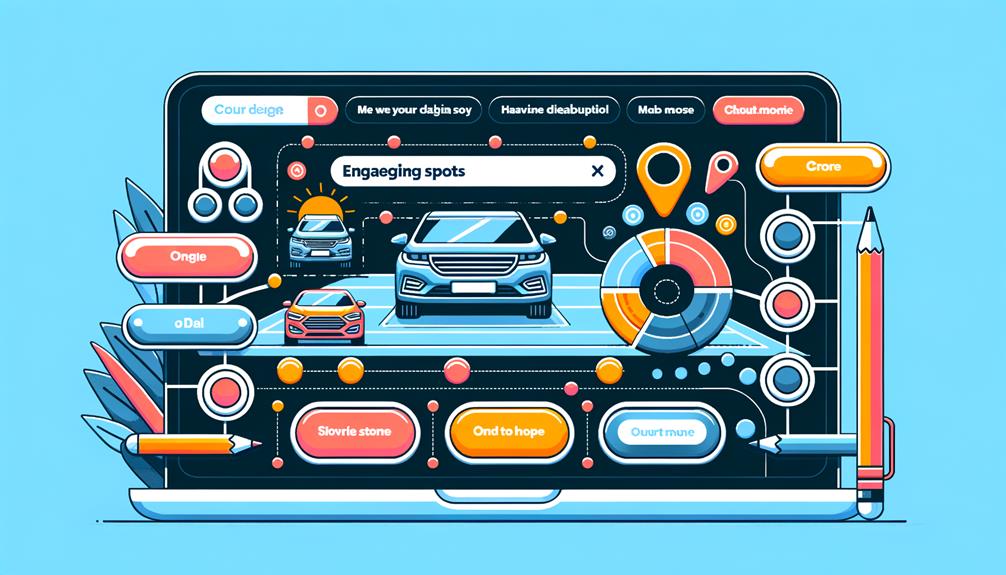Dealer websites can sometimes appear less significant in the bustling online marketplace. However, we're confident that using well-placed and effective calls-to-action (CTAs) can revamp these sites into main arteries of web traffic, delivering more customer interaction and conversions. Constructing persuasive CTAs goes beyond catchy phrases or dazzling designs; it's a strategic journey that needs a thorough understanding of your audience, their requirements, their interests, and their spot in the sales funnel. So, how can we confirm that our CTAs are spot on and genuinely inciting action? The solution involves a blend of strategies, including clever positioning and incentives, along with continuous testing and improvement. As we commence this conversation, we aim to highlight these strategies and offer practical advice on how to apply them efficiently.
Understanding Call-to-Action Basics
Grasping the fundamentals of effective call-to-action (CTA) crafting is vital to increase customer engagement and conversions. By doing so, we can shape our call to be more enticing, ultimately steering more traffic towards our dealer sites.
CTAs are the bedrock of customer engagement. When leveraged strategically, they can guide potential customers through the sales funnel, gently coaxing them towards the intended action. This action could range from subscribing to a newsletter, making a purchase, or scheduling a test drive. The most successful CTAs are those that are custom-fit to the customer's journey, fostering a sense of community.
Our CTA copy needs to be sharp and straight to the point. We need to select words that ignite a sense of urgency or importance. Also, it's important to ensure that the CTA button is clearly visible and that the link to your website is functioning and easily accessible. By effectively employing CTAs on dealer sites, we can significantly boost our conversion rates.
Crafting Compelling CTAs

Creating captivating CTAs isn't just about selecting the right words. It's about understanding where the customer is in the sales process and using language that encourages action and interaction. This is a fundamental part of building enticing CTAs and an effective online marketing strategy.
Don't forget, a great call to action is more than just prompting potential customers to click. It's about inspiring them to make a purchase, which in turn increases our conversion rates. We need to take into account the user experience, ensuring our CTA is straightforward, clear, and easy to follow. It should foster a sense of community, helping customers feel appreciated and a part of our world.
The landing page is a key player here. This is where we display our CTA, so it needs to be perfect. We need to provide value and persuade visitors that taking action is in their best interest. Offering incentives, creating a sense of urgency, and using persuasive language can help us accomplish this.
Remember, the goal is to have a conversation with our visitors, not to give a lecture. We need to engage our audience, not alienate them. So, keep the language simple and direct, avoid overused phrases, and use transition words sparingly. And most importantly, always keep your audience in mind. After all, they are the ones we're trying to reach.
CTA Placement Strategies

Effective CTA placement strategies are not just about where to put them on a page. They also take into account the customer's current position in the sales funnel. It's crucial to understand the shifts in user behavior at different stages of the journey.
Digital marketing spaces like landing pages and blog posts should contain well-crafted CTAs. These should align with the specific content and the target audience. For example, a high-level blog post might include a CTA which prompts users to download an associated guide. In return for their email address, they get more information. This method can help us gently guide leads further down the sales funnel.
Creating the perfect CTA involves more than just finding the right words. It's about strong appeals that connect with the reader. The language of content marketing is conversational, and CTAs should reflect that. By using words that speak directly to our audience, we can make them feel welcome and valued. This is how we build a sense of community and offer them something worthwhile.
Leveraging CTAs for Conversions

Utilizing calls to action (CTAs) effectively can notably enhance our conversion rates and deepen customer engagement. We've noticed that a CTA that is tailored to a customer's specific place in the marketing funnel tends to be the strongest. It's crucial to pick an appropriate CTA based on the funnel stage, which can help trigger the desired response from our target audience.
To better illustrate our method, here's a simple table:
| Marketing Funnel Stage | Tips to Create Appealing CTA | Desired Outcome |
|---|---|---|
| Awareness | Use clear, engaging language | Prompt further research, learn more |
| Consideration | Emphasize benefits, instill a sense of urgency | Assess options, start a trial |
| Decision | Use customer reviews, offer guarantees | Initiate a purchase, arrange a meeting |
| Loyalty | Offer exclusive deals, express appreciation | Recommend a friend, post a review |
Using CTAs for conversions isn't just about boosting conversion rates. It's about establishing a connection with our audience, making them feel like they're part of something. A robust, explicit, and succinct call to action can be a highly effective tool in this respect. So, bear in mind, when it comes to CTAs, the goal should always be to engage, inspire, and convert.
Testing and Improving Your CTAs

Navigating the digital world, we've come to realize that fine-tuning our CTAs can notably enhance their efficiency and lead to increased conversions. Getting to know your customers and what they need is critical in this process. Simple prompts such as 'Call us today' or 'Start your free trial' can guide users to the next step in their journey, confirming the value they get and improving customer service.
Our goal is to make sure our calls-to-action are effective, and that's why we aim for simplicity and brevity in our language. An enticing CTA is typically straightforward, concise, and provides a strong incentive. For instance, 'email marketing' may not trigger the same response as 'Get a free guide to email marketing'. The distinction lies in the perceived value.
Frequently Asked Questions
How Do You Effectively Use Call to Action?
Let's put together some powerful calls-to-action (CTAs) that perfectly fit your customers' journey. We'll use precise wording to prompt immediate responses, and we'll throw in some incentives to spark their interest and get them moving. And of course, we're never just satisfied with the status quo. We'll keep testing and refining our CTAs to ensure they're as effective as possible.
What 3 Elements Should Be in a Call to Action?
When thinking about crafting a compelling call to action, you might want to consider including these three vital ingredients: a robust action word, a dash of urgency, and a crystal clear perk for the user. If done right, these elements could work wonders in ramping up user interaction and making your call to action way more effective.
What Is an Example of an Effective Cta?
'People often come to us, inquiring about effective ways to use a call-to-action. A great example that we've seen work wonders is 'Schedule Your No-Cost Consultation Now!' It's straightforward, easy to understand, creates a sense of urgency, and provides a compelling incentive – these are all vital ingredients for a successful call-to-action.'
What Are Two Qualities for a Call to Action to Be Effective?
We think the key to a successful call-to-action is all about being straightforward and proactive. It's all about sparking a sense of immediacy, while shining a light on the perks for the user. Our call-to-actions are designed to catch your eye, keep things brief and to the point, and offer crystal clear directions.

